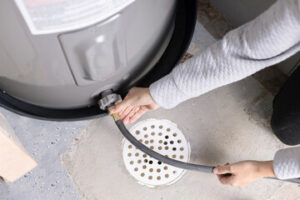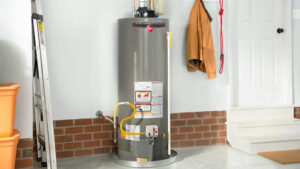Plumbing is essential in residential and commercial buildings to ensure a consistent supply of clean drinking water, proper waste disposal, and odor-free sanitation. It involves a complex network of pipes, valves, and fixtures.

It requires detailed knowledge and specialized training. A plumber must also be comfortable working in tight spaces and using a variety of tools and equipment. Visit https://bryco-plumbing.com/ to learn more.
Faucets in your home might start to leak from time to time. This is often caused by worn washers that sit on the valve seat and cause friction. Over time, this causes sediment and mineral deposits to form causing the seat to corrode. If this isn’t addressed, you might need to replace the entire faucet. However, many times, simply tightening the adjusting ring and replacing the O-rings is enough to fix the issue.
Leaks around the spout base can be fixed by re-installing the O-rings that are found underneath the spout. Depending on the faucet, these can be difficult to access, as you may need to remove the handle and other parts of the faucet. You can purchase O-ring kits at most hardware stores or plumbing supply store that are specifically designed for your faucet. Be sure to get the correct size, and coat them with nontoxic plumber’s grease before you install them.
Other faucet repair issues include leaks around the spout handle and valve seat, and a cracked disc cartridge inside the faucet handle. Most of these problems can be easily fixed with a little know how and the proper tools. First shut off water supply to the faucet. Then remove the handle held to the main body of the faucet by unscrewing the small screw at the top of the handle, or the metal or plastic button on the back of the handle. If you have trouble removing the screw or button, try using penetrating oil such as WD-40. Remove the handle and look at the main faucet assembly, if necessary using a pair of large slip-joint pliers to remove the packing nut.
Once the nut is removed, the stem can be lifted out of the faucet assembly. If there is a crack in the ceramic disc cartridge, you can replace it by buying a new cartridge. If you’re having trouble with the disc cartridge staying in place, it may need to be twisted, using a spanner tool or pliers, to line up with the retaining clip.
When you have the new cartridge in, replace the O-rings that are located under the cartridge, then reinstall the handle and faucet assembly. Make sure to hand-tighten the nut, and use a basin wrench to tighten it further. Replace the handle cap, if necessary.
Faucet Parts
Faucets are a convenient feature in your kitchen or bathroom, and they add a stylish look to the room. Whether you’re looking to improve the functionality of your existing faucet or repair a leak, you can find a variety of replacement parts to suit your needs. You can also choose from a number of special finishes and even customize the look by mixing and matching different types of faucet parts.
The main function of faucets is to control water flow and temperature, and they’re made from a variety of materials, including plastic, brass and bronze. The most common type of faucet valve is called a ball valve, which features a network of grooves and holes that align with the hot and cold water inlets. The movement of the handle controls the amount of water flowing through the valve, and this action adjusts the temperature and flow rate.
Most new faucets are made from a durable plastic called POM or polyacetal. This engineering plastic is durable, solvent-resistant and has good dimensional stability. It’s also a good choice for components that come in contact with water, such as the faucet spout’s interior.
One of the most important parts of any faucet is the water shut-off valve, which allows you to stop the flow of water for repairs or cleaning. Many faucets are also equipped with a drain hose, which removes dirty water from the sink to prevent odors and bacteria buildup.
If your faucet is leaking, a damaged handle index or tip might be the culprit. Often, these decorative pieces screw onto the handle and are easy to replace if they get loose or cracked. Another easy fix is to apply plumber’s grease, which can help lubricate the joints and nuts on your faucet, making it easier to turn the handle and reduce noise and wear.
If you have a two-handle faucet with decorative handles, start by removing the screw at the top of each handle. You’ll probably need a screwdriver to loosen the screws, and then you can pull off the handles. If your faucet has a single-hole assembly, you can cover the unused hole with an escutcheon plate that comes in a wide range of finishes to match your faucet.
Faucet Installation
Faucet installation is an easy do-it-yourself project for homeowners with some basic plumbing skills. It’s important to note, however, that this type of project can be very challenging for those who lack experience. It can also be dangerous. It’s recommended that homeowners with limited DIY experience should leave this task to a professional plumber to ensure it’s done correctly.
Before installing a new faucet, first shut off the water supply valves located under the sink or in the basement. Then, using a stud finder, locate the wall studs where you intend to mount the faucet and mark them with a pencil. Wall-mounted faucets must be securely anchored to studs for stability.
Next, remove the old faucet by loosening the nuts that hold it in place with a basin wrench or standard wrench and pliers. This is often a messy process, so have a bucket or plastic sheet on hand to catch the residual water that’s released. Once the old faucet is removed, it’s important to clean up the debris. It’s also a good idea to inspect the mounting hardware for any signs of damage.
Once you’ve removed the old faucet, it’s time to install the new one. First, ensure the new faucet is compatible with your existing pipes by checking the product specifications or consulting a sales associate. Once you’ve determined that the new faucet is a suitable match, turn on the water supply valves to test the connections. If the water doesn’t flow smoothly, adjust the pipe fittings as needed.
If you’re installing a new faucet in the same spot as an older faucet, be sure to extend the hot and cold water supply lines from their current location to the new faucet’s stub-outs. This may require soldering supplies and a crimping tool (for copper) or a barbed fitting and screwing tool (for PEX).
If you’re installing the faucet in an area where you haven’t previously had a faucet, it’s best to use flexible supply lines. This will make the job much easier and less messy. Finally, attach the escutcheon plate by applying plumber’s putty under the edges of the plate and aligning it to the hole(s). Press in place and wipe away any excess.
Faucet Maintenance
A good faucet maintenance program can help reduce issues like mineral buildup, clogs, water spots, and stains. Clients should know how often their faucets need to be cleaned and what kind of cleaner is safe to use on different finishes.
Most faucets require regular cleaning to remove residue and prevent rust and hard water buildup. A mild cleaning solution or window cleaner is a safe and effective option for most faucets. Avoid abrasive cleaners that can damage the faucet finish or scratch the surface. After cleaning, gently pat the faucet dry to keep it looking beautiful and new.
If a faucet makes a lot of noise or has erratic water flow, the problem may be caused by a stuck valve. Valve corrosion or a buildup of debris can cause the valve to stick open or closed, leading to inconsistent water flow. A professional should be called to diagnose the issue and fix it.
Every week, clients should wipe down their faucets with a soft cloth to remove dirt and grime. For those who live in areas with hard water, this is especially important. It is also a good idea to check the faucet for any signs of leaks or loose handles.
For monthly cleaning, clients should use a mild vinegar and water solution to clean the faucet and handle. For those with Spot Resist finishes, it is best to use cleaners that are specifically formulated for these types of faucets, as using harsher cleansers can lead to scratches and other surface damage.
The aerator on faucets should be unscrewed and regularly cleaned to prevent clogs. This can be done by removing the aerator and rinsing it with a mixture of water and vinegar. If the aerator is “hidden” or recessed into the faucet, it will need to be removed with a tool like a pair of pliers or wrench. Once the aerator is removed, it can be soaked in vinegar and water to loosen any hard water deposits and then rinsed with fresh water to make sure it is free of residue.



